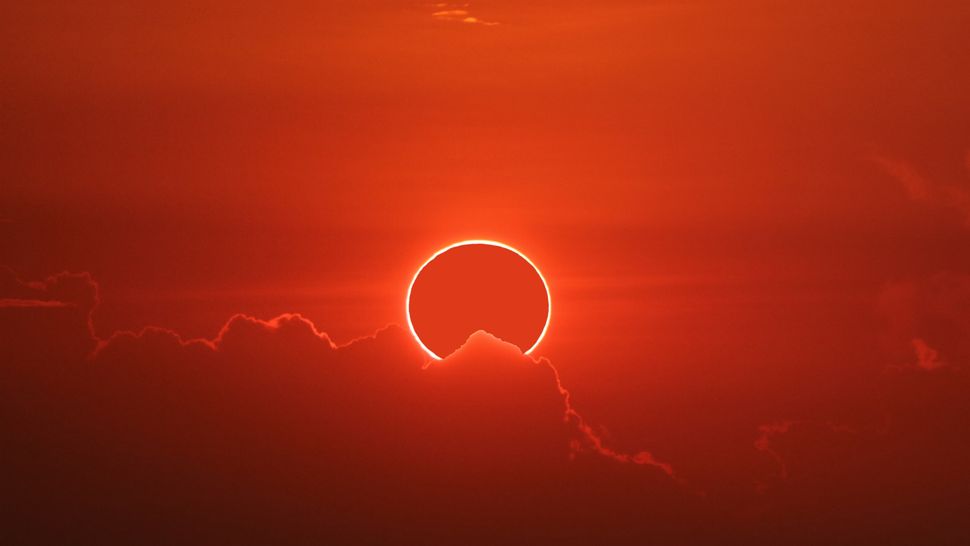


A new celestial event, a "ring of fire" annular solar eclipse, will be visible from South America and parts of Hawaii and the Pacific and Atlantic Oceans on October 2, 2024. This phenomenon occurs when the moon moves between the Earth and the sun, creating a ring-shaped silhouette of sunlight. Skywatchers are advised to use proper eye protection to view the eclipse safely.
The "Ring of Fire" Solar Eclipse of 2024
A celestial spectacle of cosmic proportions is scheduled to unfold on October 2, 2024, with the occurrence of an annular solar eclipse. This awe-inspiring event will be visible from South America, parts of Hawaii, and vast stretches of the Pacific and Atlantic Oceans.
Annular Solar Eclipse: A Cosmic Ring
An annular solar eclipse occurs when the moon passes directly between the Earth and the sun. However, instead of completely blocking the sunlight, the moon's apparent size is smaller than the sun's, creating a mesmerizing ring of light around the dark silhouette of the moon. This phenomenon is often referred to as a "ring of fire" due to its striking visual resemblance.
Path of the 2024 Eclipse
The path of the annular solar eclipse of 2024 will begin in the eastern Pacific Ocean, close to the coast of Chile. It will sweep across South America, passing over Argentina, Uruguay, Brazil, and Chile before exiting the continent. Observers in parts of Hawaii, including Mauna Kea, will also be treated to a view of this celestial event.
Eye Protection Crucial
It is crucial to emphasize that observing a solar eclipse without proper eye protection can lead to permanent eye damage. Skywatchers are strongly advised to wear certified solar eclipse glasses or use solar filters specifically designed for this purpose.
Top 5 FAQs on Solar Eclipses
Q1: Why does a solar eclipse occur? A: A solar eclipse occurs when the moon aligns directly between the Earth and the sun, blocking out the sunlight.
Q2: What is the difference between a total and an annular solar eclipse? A: In a total solar eclipse, the moon completely blocks out the sun, while in an annular eclipse, the moon is smaller than the sun, resulting in a ring of sunlight around the moon's silhouette.
Q3: How often do solar eclipses occur? A: Solar eclipses occur relatively frequently, but they are only visible from certain locations on Earth.
Q4: Are solar eclipses dangerous to view? A: Viewing a solar eclipse without proper eye protection can cause severe and permanent eye damage.
Q5: When was the last annular solar eclipse? A: The last annular solar eclipse occurred on June 10, 2021, and was visible from parts of Europe, Africa, and Asia.

As meditation gains popularity as a mental well-being tool, concerns about potential side effects have emerged. A recent study by a team of researchers from the University of Melbourne delved into the prevalence of adverse experiences among meditators in the United States. By recruiting nearly 900 adults from various meditation skill levels, the study aimed to provide more accurate estimates of how common these side effects are and what factors may contribute to experiencing them. The findings highlight the need for clearer reporting standards in future research on meditation.

Prime Minister Narendra Modi launched a groundbreaking research, development and innovation scheme that will provide a boost to the flourishing ecosystem of innovation in India. In his address at the Emerging Science, Technology and Innovation Conclave, PM Modi highlighted the crucial role of science and technology in driving transformation and emphasized on India's significant progress in the field. He also acknowledged the remarkable achievement of India's women's cricket team and expressed confidence that their success would inspire the country's youth. Attendees included renowned scientists, innovators, and distinguished guests from both India and abroad.

Indian Prime Minister Narendra Modi inaugurated the Emerging Science and Technology Innovation Conclave (ESTIC) 2025 and launched the Rs 1 lakh crore Research Development and Innovation (RDI) Scheme Fund. The scheme aims to strengthen the private sector-driven research and innovation ecosystem in the country and has a total outlay of Rs 1 lakh crore over 6 years. ESTIC 2025, gathering over 3,000 participants, focuses on 11 critical thematic areas including Artificial Intelligence, Quantum Science and Technology, and Space Technologies, providing opportunities for collaboration and reinforcing India’s science and technology ecosystem.

In this edition of Health360, a renewed debate over the alleged link between vaccines and autism is sparked by tech mogul Sridhar Vembu's endorsement of a questionable study. Despite reassurances from the medical community backed by data from the WHO, doubts continue to persist, leading to potential harm to public health. The program also delves into the alarming rise in back pain cases in India and explores new treatments.

In an effort to fight the ongoing air pollution crisis, Delhi conducted its first-ever official cloud seeding operation led by IIT Kanpur. The operation involved a small aircraft dispersing specially designed chemical flares into the atmosphere to create rain. While experts say rainfall could occur within 15 minutes to 4 hours, the actual timeframe depends on various factors such as wind direction and moisture content. If successful, the government plans to continue the operation in the coming days.

In the quest for stronger, luscious hair, we often overlook the importance of nurturing the roots. Fortunately, Ayurveda has long stressed the significance of this practice, which has now been backed by modern science. Studies have shown that herbs like Bhringraj and Amla can activate hair follicles, promoting new growth and delaying greying. Fenugreek, Neem, Hibiscus, and Ashwagandha are also found to be beneficial in strengthening and nourishing the scalp, resulting in thicker and healthier hair.

A college student shares her personal journey of becoming a vegetarian, despite facing challenges and health concerns. She then delves into an ethics class she took, where the concept of marginal cases were discussed. Following an article by philosophy professor Alastair Norcross, she concludes that even though individual action may seem insignificant, refusing to consume factory-farmed meat holds moral significance due to the potential to prevent immense suffering for animals.

On October 24, the global community commemorates World Polio Day to honor the legacy of Dr. Jonas Salk and the efforts of countless individuals and organizations in the fight against polio. This highly contagious and potentially deadly disease, once a widespread epidemic, is now largely preventable thanks to the development of a life-saving vaccine. India's successful eradication of polio serves as a testament to the importance of strong vaccination programs and collaborations in public health initiatives.

As winter arrives in India, so does the hazardous air pollution. Delhi NCR's AQI has already crossed the 400 mark, making it crucial to invest in air purifiers, especially after Diwali. Dyson, Qubo, HomePure, and Philips have launched high-quality air purifiers with advanced features to tackle different types of pollutants and create cleaner indoor air. With prices ranging from Rs 5,000 to Rs 1 lakh, these purifiers are a practical and timely purchase for a healthier living.

In a recent family vlog, Indian celebrity couple Shoaib Ibrahim and Dipika Kakar shared their "natural" hair care routine for their son, using a homemade mask made with rice flour, flax seeds, and coconut oil. However, experts warn that what works for adults may not be suitable for babies, whose sensitive skin and scalp could react to the ingredients. While the ingredients may improve hair texture, they do not necessarily promote hair growth. Instead, a healthy diet and good scalp care are more important in maintaining healthy hair.